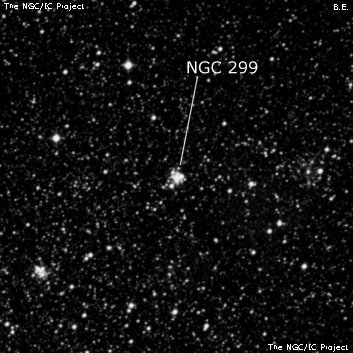
John Herschel discovered NGC 299 = h2360 on 12 Aug 1834 and recorded this SMC cluster as "F; vS; R; glbM; r; 15"." His fourth and final record reads "pB, vS, R, 12", resolvable. Situated at the upper limit of the nubecula which here is starry. At the other it is nebulous."
This cluster is misclassified as a Bright Nebula in the RNGC, and the wrong type was copied into the NGC 2000.0 and first edition of the Uranometria 2000.0.
400/500mm - 18" (7/11/05) - Magellan Observatory, Australia): at 228x appeared fairly bright, fairly small, round, 50" diameter with a broad weak concentration. Forms a pair with NGC 306 5' SE.
18" (7/9/02 - Magellan Observatory, Australia): at 128x, this SMC cluster appeared as a small, round, bright knot, ~45" diameter. Forms the southeast vertex of an obtuse triangle with two mag 11 stars ~3.5' NNE and 4' W. Forms a trio with NGC 306 4.7' SE and Kron 30 3.8' W. Kron 30 appeared as just a hazy patch, ~1.5' diameter with a few mag 13/14 stars superimposed or resolved.
18" (7/6/02 - Magellan Observatory, Australia): this is the first of two small knots of stars (the other being NGC 306) located 26' W of NGC 346. At 171x, it appeared as a small glowing spot, ~40" in diameter, though standing out fairly well in the field. The cluster is embedded within a scattered group of brighter stars in the field. Forms a pair with NGC 306 4.7' SE. The second edition of Uranometria 2000.0 and DSFG incorrectly list both objects twice - as open clusters and bright nebulae.
600/800mm - 25" (10/17/17 - OzSky): at 244x; bright, fairly small, round, high surface brightness, 0.8' diameter. Contains an intensely bright quasi-stellar nucleus. A few stars were resolved at the edges at 397x. Brightest in a group of clusters with NGC 306 5' SE, Kron 30 3.7' W, Lindsay 51 8.5' NE, and Kron 28 14' NW.
Lindsay 51 appeared moderately bright, fairly small, irregular shape, ~30" diameter, very small bright nucleus. Situated just 0.6' W of a mag 10.6 star (SMC yellow supergiant) in a rich section of the SMC.
Kron 28 appeared fairly faint, moderately large, round, ~45" diameter, low surface brightness glow extending to the west of mag 10.7 HD 5148 = V Tucanae (mag 10-12 eclipsing binary superimposed at east edge).
Notes by Steve Gottlieb